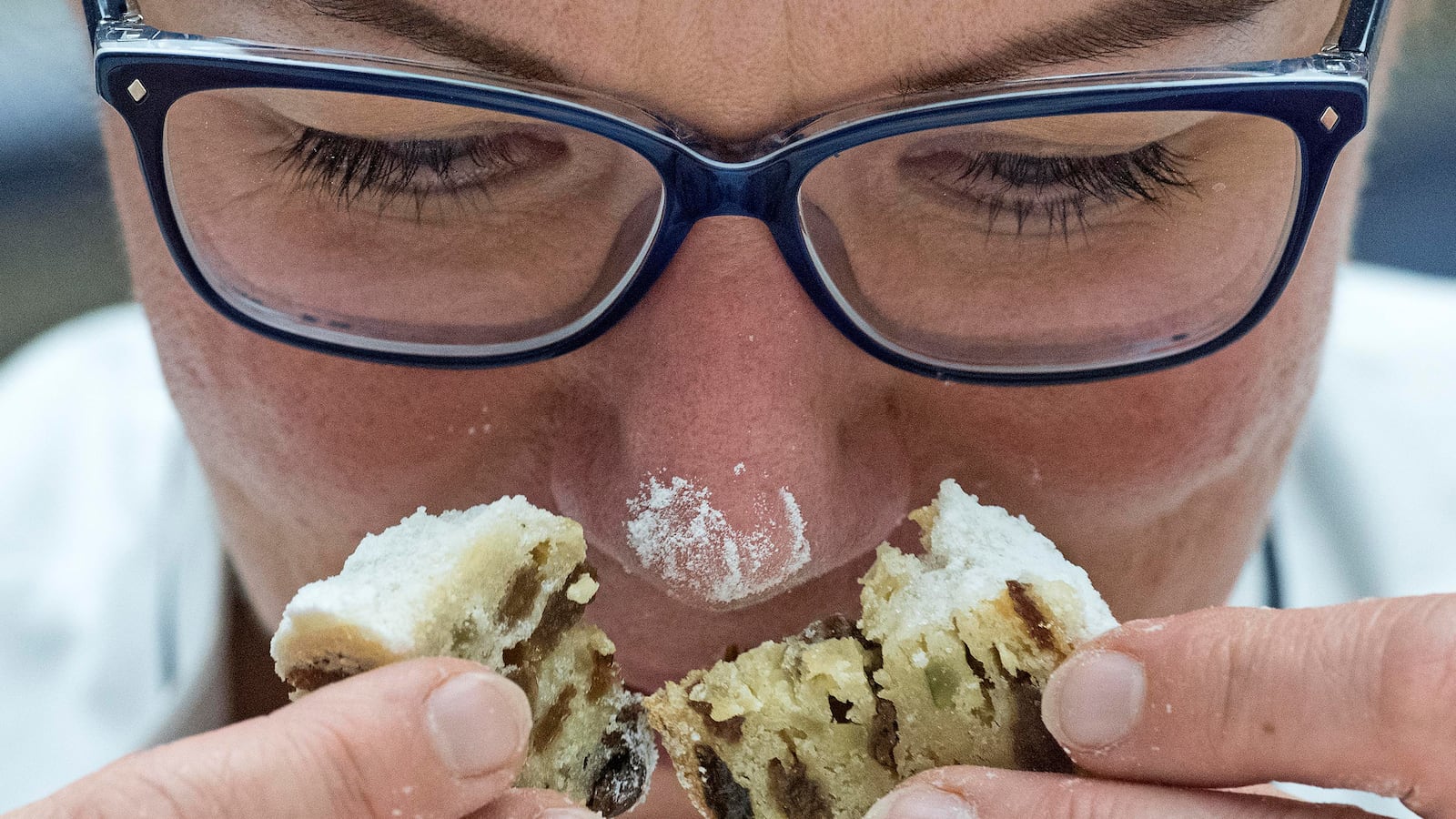Stollen first appeared in 1329, in Naumburgh an der Saale (near Leipzig, Germany), and was solely composed of oats, water, flour, and rape seed oil (canola oil). Like Lent, the season of Advent was a period of reflection and fasting, and items such as dairy and sugar were forbidden. It was known as Christstollen (Christ cake), and is simply referred to as Stollen today.
It was not until 1400s when the Roman Catholic Church softened its Advent rules that Catholics both in Rome and elsewhere were allowed to use butter. The Butterbrief, issued by Pope Innocent VIII, was a turning point for the then bland Stollen, which gradually became sweeter. The tasteless bread was transformed into a sweet cake that included ingredients, such as dried fruit and marzipan.
Today, different iterations of Stollen exist both in and outside Germany, but tend to be lighter than the original yuletide loaf, which usually weighed about ten pounds. According to German food writer and author of Food Culture in Germany, Ursula Heinzelmann, “Stollen—at least industrialized stollen is now overloaded with marzipan in Germany.” Ironic, since it was originally meant to suppress sugar lust.
The tradition of baking of Stollen is probably the strongest in Dresden, Germany. There’s even an official festival that centers around the Jesus-loaf, which began under the reign of King Augustus II, the Elector of Saxony.
Augustus, also known as Augustus the Strong, was a party-boy, and loved any excuse to celebrate. He also had a sweet tooth, and a soft spot for the fruity Stollen—so much that in 1730, he ordered the bakers guild of guild of Dresden to concoct a giant Stollen cake, which weighed in at about 25 pounds.
A big cake requires a big festival, and Augustus was happy to comply. He had a special knife designed to cut the dense loaf, and a ceremony to precede cutting the cake. The Stollen was paraded through the city of Dresden, and later an appointed “Stollen girl” cut the cake. Today, it is known as the Dresden Stollen Festival, and takes place on the Saturday before the second Sunday of Advent.
The Dresden Stollen Festival still attracts a large following of stollen-lovers, and passing tourists—all eager to kick off the Advent season with a 300-year old tradition.
As Heinzelmann points out in her book, Food Culture in Germany, German food varies by region, and is much more diverse than outsiders think. The same is true of stollen. Berlin Stollen is made with quark and baking powder (as opposed to the sour dough version, which is made with yeast), while the Dresden version is a sweet-yeasted bread with citron and currants.
Other versions are coated in marzipan, or dusted in powder sugar. In her book, Heinzelmann, says that it is “hard to believe that Stollen originally started as a cake for the Advent fasting period before Christmas.” Now, it is the most traditional and celebrated Christmas cake in Germany—and definitely not associated with fasting.
Heinzelmann sees Stollen as another indication of Germany’s long history of culinary innovation, and unique ability to adapt to change, reinvent dishes, and yet maintain traditions in the face of political upheaval and socio-economic change.
When I met Heinzelmann in 2011 in Berlin, she discussed how Berlin and greater Germany’s evolving food culture relied on openness—making the Stollen’s existence and evolution all the more likely.
The German attitude towards food traveled well during the 19th century and the years preceding World War I, when an influx of German immigrants arrived in the United States.
Rather than coming and conquering, this wave of Germans brought the tradition of the Christmas tree, established kindergartens, and introduced the American palate to Stollen, and what later was referred to as fruitcake.
Fruitcake quickly acclimated to its American home, and even plays a supporting role in American literature. Truman Capote wrote fondly about making fruitcake with his Aunt Shook, which he recalled in semi-autobiographical short story, A Christmas Memory.
The story takes place in Alabama during the Depression, and follows “Buddy” (who is Capote as a young boy) and his Aunt Shook’s fruitcake-making endeavors. The story begins with eccentric Shook, waking up and saying, “I knew it before I got out of bed…It’s fruitcake weather!”
Buddy and Shook make an unlikely duo, which is part of the story’s charm. They’re both outsiders, and take refuge in each other’s company. They also love Christmas, and are determined to make it cheerful and to give gifts.
The story carries the reoccurring Christmas narrative generated by Charles Dickens’ A Christmas Carol, where the theme of celebrating Christmas, despite all odds, plays a pivotal role.
Buddy and Shook do manage to scrape together enough money to buy the ingredients to make fruitcakes. They rove from farm to farm, dipping into their pockets for loose change and other items possibly worth bartering to buy dried pineapple, raisin, baking powder, vanilla, whisky, and nuts. They even send a loaf to President Roosevelt.
Both Buddy and Shook shared the same enthusiasm that Augustus shared for Stollen, and recognized it as the beginning of the Christmas season. Oddly, the Stollen’s original makeup of oats, flour, and water, has served it well—transitioning from one century to the next, growing sweeter with time, traveling overseas, yet remaining emblematic of the German Christmas tradition. Its powers of piety and innovation still endure.






